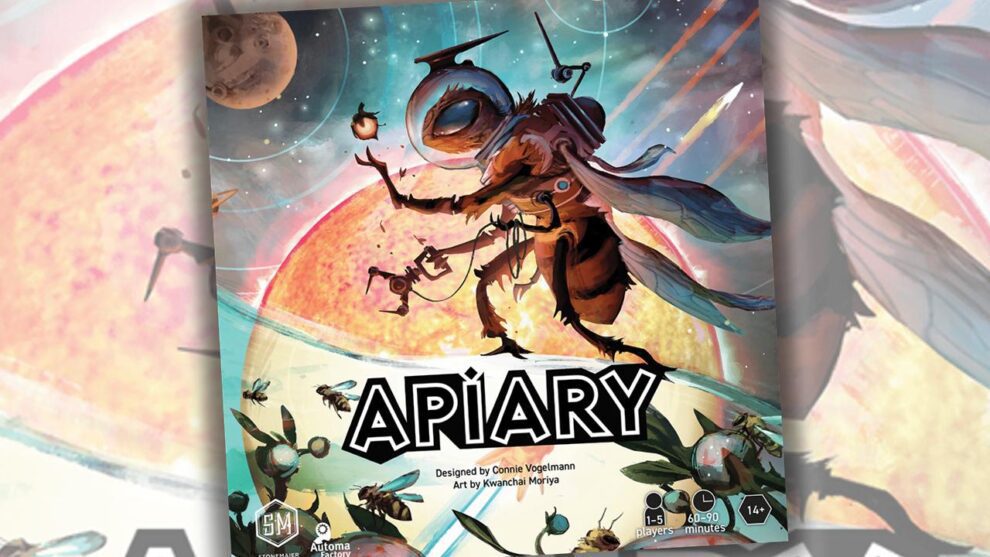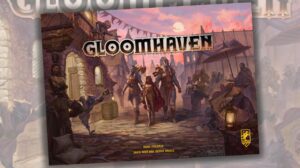Disclosure: Meeple Mountain received a free copy of this product in exchange for an honest, unbiased review. This review is not intended to be an endorsement.
Games are technologies that help individuals and groups think in novel ways, so it totally tracks that a game about space bees would utilize the latest and greatest in worker placement technology.
That’s Apiary, a game that’s a blend of high-tech worker placement wizzbangs and classic resource converter conventions, for better—and in some cases—for worse.
Bees in the trap
In Apiary, you’re space bees, developing your personal hive board with resources that you collect throughout your bee-space-odyssey: Water, green Chex Mix breadsticks (fiber), yellow splats (pollen), Rollos (wax), and honey pots.
Space bees are remarkably similar to regular bees in that they fly around and land on things and collect them for use by the hive, which I suppose is you, the player. Disclosure: I know nothing about bees other than the one summer I stayed with an apiarist on a bike tour.

You have four rotatable rectangular plastic bees with numbers that range in from 1-4. This represents their strength, and when you place them on different action spaces, stronger workers can do more powerful actions, and in the case of several spaces, you sum the strengths of the bee that is on the other space to do great stuff. Strength 4 bees typically grant a more powerful action in addition to the other actions that you gain from a space.
There are six different worker placement actions, but generally they are of two types. You’ve got an explore action, which lets you fly a shared big bee ship around and collect resources, growing the amount of resources gained from each space for future gathering(s). There are several actions that expand your hive, where you can go and purchase hex tiles that grant one time bonuses, endgame scoring, passive abilities, and storage/resource income (when you take the retrieval action). There are cards that you can collect from another action, which can be played before or after an action. I always like the “play as many cards as you want” style of card power, which you can see in Hallertau, Calimala, and other euro resource converters.
My personal favorite action is a twist on the typical “convert things to other things” action, Convert, which allows you to, with a worker of high-enough strength, create a custom conversion that every player can use for the rest of the game, with you receiving a kicker benefit each time it’s used by an opponent.
Bumper bees
Apiary builds on some fun worker placement antics that you see in Cryo, where you’re putting the workers out (though the drones in Cryo are robotic), and then bringing them back to your board with a separate action to gain income (and increase the strength of the workers). There’s a lot more here than the aforementioned game, however, where you not only get income, but some of your workers (strength 4) might increase themselves into hibernation (like the dead ones in Teotihuacan). This means that they have to be gathered again from a supply next to the board. When strength 4 bees are sent to the great honeycomb in the sky, their owner has to place a hibernation token and get a bonus from the main board, which serves as the game clock. Once all the hibernation spaces are full (or one player runs out of hibernation tokens) the game is over.

Additionally, Apiary agrees with me that worker placement games that feature blocking of spaces are dumb and subject to turn order binding problems—so, it doesn’t have blocking. Instead, when you want to place a worker somewhere, you bump out the old worker, who returns to its owner. They then choose to increase its strength or not, and if not, they send it to a separate area to be used for income but not for actions.
Both of these mechanisms result in a fun little hive-like flow, where the bees be flyin’, and the resources are gathered. The game board grows organically as everyone exploits it, and the game doesn’t overstay its welcome.
The only downside, which is the case for many Stonemaier games, is that there’s a bit of sour randomness that stops it from being a competitive experience. Because of the way that you’re building your own hive puzzle, and the three hex markets for building said puzzle, typically players embark on divergent paths to victory. And, because these markets are random, players might get arbitrarily rewarded for pursuing a strategy based on a market flop, and personally, I find that unsatisfying.
But if you set aside that this is going to be a super-serious-game-tournament-competitive experience, you can have a pretty good time with Apiary. Hopefully, they don’t do a wasp expansion.











